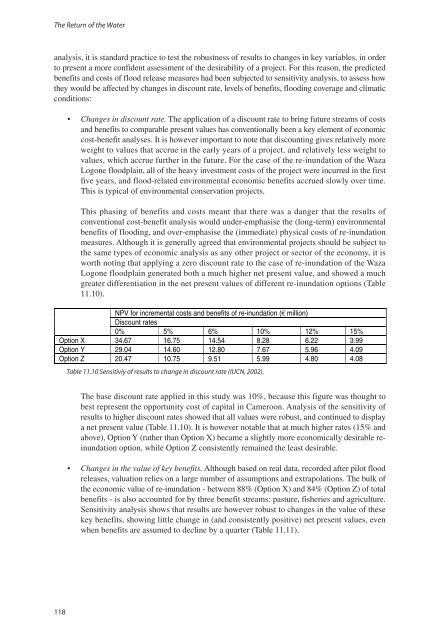The return of the water - IUCN
The return of the water - IUCN
The return of the water - IUCN
Create successful ePaper yourself
Turn your PDF publications into a flip-book with our unique Google optimized e-Paper software.
<strong>The</strong> Return <strong>of</strong> <strong>the</strong> Water<br />
analysis, it is standard practice to test <strong>the</strong> robustness <strong>of</strong> results to changes in key variables, in order<br />
to present a more confident assessment <strong>of</strong> <strong>the</strong> desirability <strong>of</strong> a project. For this reason, <strong>the</strong> predicted<br />
benefits and costs <strong>of</strong> flood release measures had been subjected to sensitivity analysis, to assess how<br />
<strong>the</strong>y would be affected by changes in discount rate, levels <strong>of</strong> benefits, flooding coverage and climatic<br />
conditions:<br />
118<br />
• Changes in discount rate. <strong>The</strong> application <strong>of</strong> a discount rate to bring future streams <strong>of</strong> costs<br />
and benefits to comparable present values has conventionally been a key element <strong>of</strong> economic<br />
cost-benefit analyses. It is however important to note that discounting gives relatively more<br />
weight to values that accrue in <strong>the</strong> early years <strong>of</strong> a project, and relatively less weight to<br />
values, which accrue fur<strong>the</strong>r in <strong>the</strong> future. For <strong>the</strong> case <strong>of</strong> <strong>the</strong> re-inundation <strong>of</strong> <strong>the</strong> Waza<br />
Logone floodplain, all <strong>of</strong> <strong>the</strong> heavy investment costs <strong>of</strong> <strong>the</strong> project were incurred in <strong>the</strong> first<br />
five years, and flood-related environmental economic benefits accrued slowly over time.<br />
This is typical <strong>of</strong> environmental conservation projects.<br />
This phasing <strong>of</strong> benefits and costs meant that <strong>the</strong>re was a danger that <strong>the</strong> results <strong>of</strong><br />
conventional cost-benefit analysis would under-emphasise <strong>the</strong> (long-term) environmental<br />
benefits <strong>of</strong> flooding, and over-emphasise <strong>the</strong> (immediate) physical costs <strong>of</strong> re-inundation<br />
measures. Although it is generally agreed that environmental projects should be subject to<br />
<strong>the</strong> same types <strong>of</strong> economic analysis as any o<strong>the</strong>r project or sector <strong>of</strong> <strong>the</strong> economy, it is<br />
worth noting that applying a zero discount rate to <strong>the</strong> case <strong>of</strong> re-inundation <strong>of</strong> <strong>the</strong> Waza<br />
Logone floodplain generated both a much higher net present value, and showed a much<br />
greater differentiation in <strong>the</strong> net present values <strong>of</strong> different re-inundation options (Table<br />
11.10).<br />
NPV for incremental costs and benefits <strong>of</strong> re-inundation ( €<br />
million)<br />
Discount rates<br />
0% 5% 6% 10% 12% 15%<br />
Option X 34.67 16.75 14.54 8.28 6.22 3.99<br />
Option Y 29.04 14.60 12.80 7.67 5.96 4.09<br />
Option Z 20.47 10.75 9.51 5.99 4.80 4.08<br />
Table 11.10 Sensitiviy <strong>of</strong> results to change in discount rate (<strong>IUCN</strong>, 2002).<br />
<strong>The</strong> base discount rate applied in this study was 10%, because this figure was thought to<br />
best represent <strong>the</strong> opportunity cost <strong>of</strong> capital in Cameroon. Analysis <strong>of</strong> <strong>the</strong> sensitivity <strong>of</strong><br />
results to higher discount rates showed that all values were robust, and continued to display<br />
a net present value (Table 11.10). It is however notable that at much higher rates (15% and<br />
above), Option Y (ra<strong>the</strong>r than Option X) became a slightly more economically desirable reinundation<br />
option, while Option Z consistently remained <strong>the</strong> least desirable.<br />
• Changes in <strong>the</strong> value <strong>of</strong> key benefits. Although based on real data, recorded after pilot flood<br />
releases, valuation relies on a large number <strong>of</strong> assumptions and extrapolations. <strong>The</strong> bulk <strong>of</strong><br />
<strong>the</strong> economic value <strong>of</strong> re-inundation - between 88% (Option X) and 84% (Option Z) <strong>of</strong> total<br />
benefits - is also accounted for by three benefit streams: pasture, fisheries and agriculture.<br />
Sensitivity analysis shows that results are however robust to changes in <strong>the</strong> value <strong>of</strong> <strong>the</strong>se<br />
key benefits, showing little change in (and consistently positive) net present values, even<br />
when benefits are assumed to decline by a quarter (Table 11.11).












